Avoiding Commodity Status
PCs do not need to be commodities: a focus on quality can differentiate both products and services. Software has great potential for getting better, as shown by an under-appreciated feature in Windows XP that can save users $2,000 per year.




















